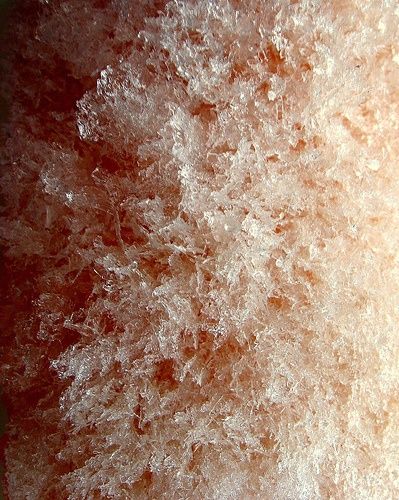For 25 points, identify the following protein:

Didn’t think so…
Spring is the perfect time for deep cleaning. Shaking off the dust and cold and mold of winter, letting fresh air in – We do it to our homes, (hopefully), and we need to do it to our freezers as well.
Whether you’ve got a combo fridge/freezer, or a big ol’stand alone unit, it’s time to thoroughly clean that beast, inventory what’s there with a critical eye, toss what needs to be tossed and cook what must be cooked before that too goes to the great beyond.
This line of reasoning naturally brooks the question, “Can food go bad in the freezer?” The answer to which is a definite ‘Yup!’
Keep in mind that freezing does not kill bacteria, yeast, mold, etc – it just pretty much keeps them from multiplying. If there was something funky present prior to freezing, it could indeed reappear when thawed. Additionally, freezing does not do any favors for food quality or taste – over time, great stuff will become good and good stuff becomes that image up yonder.
When does quality starts to degrade? That depends on what it is, and how well it was packaged, frankly. For answers to this and other freezer questions, hop on over to the USDA’s Food Safety site and read for yourself. You’ll also find the National Center For Home Food Preservation a wealth of good info.
In general terms, anything that looks like the image above – an obvious victims of freezer burn – needs to go. If flesh looks substantially different than it usually does when thawed, (Darker, off color, dried out, etc), then give it the heave ho. Trust me when I say if it looks funky, it’ll taste funky, and it could well be dangerous.
When you package for freezing, head back to the NCHFP site and read up on best practices.
The time to clear out your freezer is also the time to clean; this should be done at least annually. The best time do the deed is when stocks are low – AKA, the end of winter.
Pull everything out and put it into a fridge or cooler(s) while you clean.
Turn off, unplug, and thoroughly defrost your unit.
Once it’s to room temp, clean the insides thoroughly; I like a bleach solution for the job, but dish soap and water works fine too. Remove and clean all the shelves, racks, drawers, etc as well.
Do a rinse wipe with a solution of 2 Tablespoons of baking soda to a quart of warm water, then wipe that down with a clean, dry cloth.
Don’t forget the unseen parts – Pull the freezer from its normal locale and clean underneath. Inspect the back and clean that and the top, and dust the coils if your unit has exposed ones.
Optimal freezer temp for food storage is -15ºF to -5ºF; it should never go above 15ºF for any extended length of time.
Fire ‘er back up, let it get fully cold and then put your bounty back in – and mark your calendar for the same time next year.

Does your grill look something like this after a winters slumber? Time to get after that before you fire up for the first time.
Open up and remove the grill grates. If you’ve got a gas rig, disconnect the fuel from the grill, remove the flame deflectors and burners from the grill body. Remove all old briquettes, burned whatever, and scrape as much grease and char off as you can by hand.
For the deep cleaning, you’ll need a grill brush, a heavy duty sponge, a scrubby pad and steel wool, a bucket of hot, soapy water, another of hot, clean water, some rags, and some degreaser. I recommend Simple Green, it’s effective and environmentally sound.
Have at the entire grill with the degreaser first, allowing it some working time before you scrub. Move onto the soapy water, then the rinse, until your grill looks as close to new as you can get it. FYI, if you’re a heavy user, a mid-season cleaning won’t hurt. Thoroughly clean every component, including the grates. A seasoned grill is a good thing, but excessive grease and char build up can lead to flaring, burning and off-putting flavors in your food. A clean grill will last far longer than a dirty one as well.

Kick the Tires & Light the Fires
Now give your grill a point by point, detailed inspection of every component. Check grill and charcoal grates for rust, rot or missing and chipped porcelain. After they’re clean, dry, and inspected, you’ll re-season them. Check your framework and lid to make sure they’re all sound and there are no nuts, bolts, struts, or wheels missing or damaged.
If you use a gas grill, check your tank, valve, line, regulator, burners and flame deflectors to make sure they’re clean and sound. Don’t screw around with gas parts; if they’re rotted or badly rusted, replace them. At the least, your grill will cook poorly; at worst, you could have a genuine explosion or fire hazard brewing. If you need parts, Home Depot carries quite a few, and of course there’s probably a local supplier not to far from most of us.
When you’re ready to rock, season your grates prior to first use. Soak some paper towels with cooking oil and thoroughly rub all surfaces of the grates. Turn on the gas or light a small charcoal fire and heat the grill to high with the cover open until the oil burns off. Now turn the heat down to low and let the grill work for about fifteen minutes or, (or until your charcoal expires).
Let the grill cool down, then wipe the grates down and reapply a thin coating of fresh oil; those last steps are always a good idea after grilling, to prepare for your next session and extend the life of the grates by making sure rust doesn’t form.
Now your grill is ready to rock and roll but… Got fuel? It’s the first thing we need and the first one we forget on friday night when we step out the back door with a platter of steaks. Inspect any charcoal, smoking or seasoning woods and pellets, and gas tanks left over from last season. If any of your briquettes or woods got soaked, you’re OK if they retained their shape and what soaked them was just water. Set affected fuel out to dry and repackage as needed after they’re ready to go.
While we’re on the subject of charcoal, avoid instant light products and charcoal lighter fluid like the plague. It’s bad enough that the stuff contains things you don’t want to feed your family, and even worse that they absolutely ruin the flavor of good food. Get yourself a lighting chimney that works off scrap paper and use that; it’s just as fast, far cheaper, and makes better food.
Finally, charcoal quality does count. Crappy generic charcoal is the equivalent of mystery meat hot dogs; you’ve got no idea what’s in there and it’s likely none of it is good. High quality lump charcoal heats better, longer and more consistently, and that too means better food.

I heard Urb on A Way With Words. I think your blog’s name is witty. Now I’m off to explore your blog. Cheers!